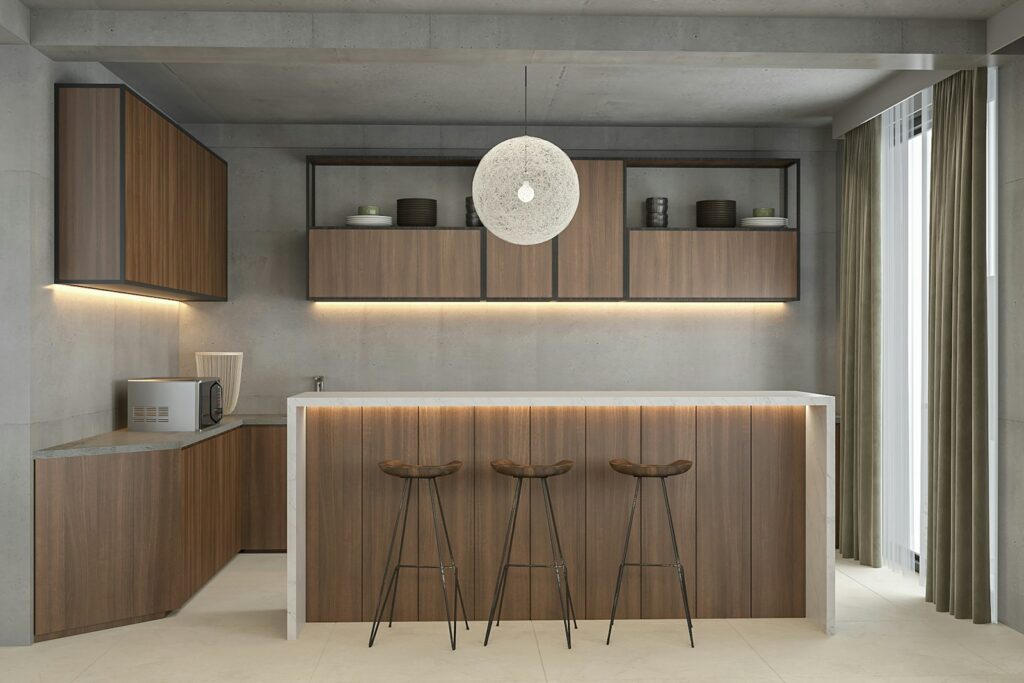laminate flooring can be installed in a kitchen, but it’s important to choose a water-resistant or waterproof option to withstand spills and moisture. Proper installation with sealed seams is crucial to prevent water damage to the subfloor, and regular maintenance, including prompt cleanup of spills and avoiding excessive water during cleaning, is essential. Selecting a laminate flooring product with a durable wear layer will help it withstand the heavy foot traffic and potential impacts common in a kitchen environment. Overall, with these considerations in mind, laminate flooring can offer the look of hardwood with easier maintenance and often at a more affordable price point for kitchen spaces.
Installing Laminate Flooring in Kitchens
To install laminate flooring in a kitchen, begin by preparing the subfloor, ensuring it’s clean, level, and dry. Acclimate the laminate flooring to the room’s temperature and humidity for at least 48 hours before installation. Lay down a foam underlayment for cushioning and moisture protection. Plan the layout, starting from one corner of the room and working outward, considering the best direction to lay the planks. Cut and install the first row, ensuring a snug fit against the walls with spacers for expansion gaps. Continue installing rows, staggering end joints and cutting planks to fit around obstacles. Install transition strips at doorways or thresholds for a finished look. Finally, add baseboards and trim around the perimeter of the room, inspect for any gaps or issues, and clean up debris. Always follow the manufacturer’s specific installation instructions for the best results.

Considerations
Before installing laminate flooring in a kitchen, several important criteria should be considered. Firstly, prioritize water resistance, opting for laminate designed specifically to withstand moisture and spills common in kitchen environments to prevent damage and warping. Durability is crucial, so select laminate with a robust wear layer, preferably with a high AC rating, capable of withstanding heavy foot traffic and impacts. Additionally, choose flooring that’s easy to maintain, as kitchens require frequent cleaning; look for stain-resistant options that are simple to wipe down. Ensure the subfloor is in good condition, level, and adequately dry before installation to prevent issues later on. Aesthetic appeal matters too, so consider the design, color, and texture of the laminate to ensure it complements your kitchen’s overall look.
Maintenance and Cleaning Tips
Regularly sweep or vacuum your laminate floor to remove dirt and debris. Use a damp (not wet) mop for cleaning. Avoid abrasive cleaning tools that could damage the surface.
Wipe up spills promptly to prevent any potential damage. For tougher stains, use a manufacturer-approved cleaner and follow the recommended cleaning instructions.
Laminate flooring is relatively easy to repair. Minor scratches or dents can often be fixed with laminate repair kits available on the market.
Pros
- Affordability: Laminate flooring is typically more affordable than hardwood or tile options, making it a budget-friendly choice for kitchen renovations.
- Easy Installation: Laminate flooring is designed to be DIY-friendly, with click-lock or glueless installation systems that make it relatively easy to install without professional help.
- Variety of Styles: Laminate flooring comes in a wide range of styles, colors, and patterns, allowing you to achieve the look of hardwood, tile, or stone at a fraction of the cost.
- Durability: High-quality laminate flooring is scratch-resistant and can withstand heavy foot traffic, making it suitable for busy kitchen areas.
- Moisture Resistance: Some laminate flooring products are water-resistant or waterproof, offering protection against spills and moisture, which is beneficial in a kitchen environment.
Cons
- Moisture Sensitivity: While water-resistant laminate exists, traditional laminate flooring can be susceptible to moisture damage if spills are not promptly cleaned up or if there are any gaps in the seams.
- Limited Repair Options: Unlike hardwood flooring, damaged laminate planks cannot be sanded down and refinished. Instead, damaged planks often need to be replaced entirely, which can be inconvenient and costly.
- Less Authentic Look and Feel: While laminate flooring can mimic the appearance of hardwood or tile, it may lack the authenticity and warmth of natural materials.
- Sound and Feel: Laminate flooring can sometimes feel hollow underfoot and may produce a tapping sound when walked on, which may not be as desirable as the solid feel of hardwood or tile.
- Not Eco-Friendly: Laminate flooring is typically made from synthetic materials, which may not be as environmentally friendly as sustainable hardwood or tile options.
Read More




